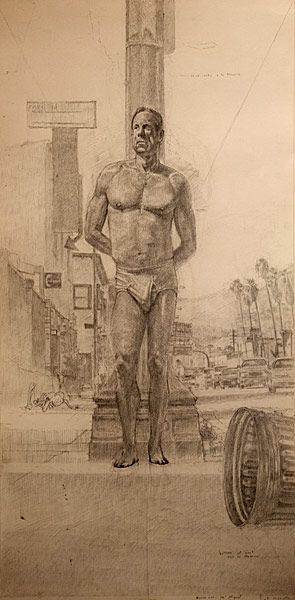
Study for St. Sebastian on Sunset #2
(pencil on bristol, 30″ x 15″, 2002)
ARTIST’S STATEMENT
I agree with Ayn Rand’s definition of art as she stated it in The Romantic Manifesto, 1969, which, to translate loosely, says that art is a selective re-creation of reality according to the dictates of an artist’s meta-physical value system. Through art, artists re-create their universe, their world, or a piece of their world, emphasizing what they think is memorable, important and timeless about their experience here.
As a rule, my work is not about the narration of specific events, but about contemplation in visual terms, of my world, specifically the people, objects, places, and experiences that make up reality for me, as revealed by light.
The urge to represent the three-dimensional world on a two-dimensional surface with charcoal, paint or whatever medium, has been with us since we lived in caves. So often, looking at paintings, we are caught up in the illusions they present; animals, flesh, food, fabric, foliage etc. More than that, we may marvel at the subtleties of a person’s facial expression or a certain quality of light that an artist has effected. But what we are really looking at however, is chemical or mineral pigments suspended in a vehicle (usually egg, oil or plastic,) that have been manipulated and “transformed” by the artist. This is magical and borders on alchemy.
My approach to selectively re-creating reality comes from the early Renaissance, the art of the Venetians, and Giovanni Bellini. Although I rarely depict overt religious subject matter, I am inspired by the way Bellini and his contemporaries depicted objective reality (the people and places of their time,) in the context of altarpieces and traditions of Byzantine icon painting.
If Bellini is remembered for any one thing, it would be for light. Whether he painted a rock, tree, person, mountain or sky, light became a metaphor for Spirit.
“As the air fills everything and is not confined to one place’, says Sebastian Franck, the sixteenth-century mystic, in his Paradoxa, ‘ as the light of the sun overflows the whole earth, is not on earth, and yet makes all things on earth verdant, so God dwells in everything and everything dwells in Him.” Landscape into Art, Kenneth Clark, 1949, page 25.
I aim for similar effect in my own work.